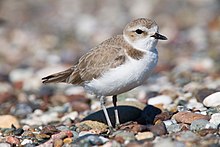Moss Landing Wildlife Area

Moss Landing Wildlife Area is a California State wildlife preserve on the shore of Elkhorn Slough.
Description
The Moss Landing Wildlife Area protects 728 acres (295 ha) of
A small strip of the reserve (the easiest to access) lies just east of Highway 1 (called the Cabrillo Highway) at 36°48′44″N 121°47′5″W / 36.81222°N 121.78472°W opposite the Moss Landing Yacht Harbor.[3] Other sections lie north of Elkhorn Slough, and west of the slough after it turns to the north, at 36°51′3″N 121°45′49″W / 36.85083°N 121.76361°W. To access the north shore section, a trailhead is off Highway 1 between the two intersections of Struve Road, at 36°49′41″N 121°46′21″W / 36.82806°N 121.77250°W. A level Marsh Trail runs from this area to a small picnic area, and then the main channel of Elkhorn Slough.[4]
The eastern shore of Elkhorn Slough is protected as part of the Elkhorn Slough National Estuarine Research Reserve.[3] Moss Landing State Beach and Zmudowski State Beach provide access to the Monterey Bay directly west of the wildlife area.
History

In the late 1800s about 200 acres of what is now the wildlife area were salt evaporation ponds used to commercially produce sea salt for use in local fish canneries. Owned by the Moss Landing Salt Works,[5] the ponds were abandoned in 1974.[6] The wildlife area was established by the state of California in 1984, and was managed in cooperation with the Monterey Bay National Marine Sanctuary when it was established in 1992.[7]
The former salt ponds provide habitat for several shorebird species. The number of
In 1999 the ponds were identified as the most critical breeding habitat in the Monterey Bay region for the plovers. In 2006 a managed tidal flow was improved, funded by Ducks Unlimited, the California Wildlife Conservation Board and the National Fish and Wildlife Foundation.[14] In late fall water levels are raised to encourage roosting brown pelicans.[15] In early spring (March or April) the ponds are drained and before the mud dries, volunteers are organized into a "mudstomp" to create shallow impressions as nesting sites.[13]Binoculars, telescopes, or cameras with telephoto lenses are best used for viewing since observers are restricted from getting too close.[16][11]
References
- ^ "Elkhorn Slough Area Access and Activity Guide" (PDF). Elkhorn Slough Foundation. July 2010. Archived from the original (PDF) on October 29, 2010. Retrieved December 4, 2010.
- California Department of Fish and Game. Retrieved December 4, 2010.
- ^ a b Stacey Lee (July 2009). "California Department of Fish and Game Central Region" (PDF). map of Elkhorn Slough National Estuarine Research Reserve and Moss Landing Wildlife Area. Archived from the original (PDF) on October 8, 2010. Retrieved December 4, 2010.
- ISBN 9780899973883.
- ^ Monterey County Free Libraries
- ISBN 0520217128.
- ^ a b "Moss Landing Wildlife Area". A Review of Marine Zones in the Monterey Bay National Marine Sanctuary. National Oceanic and Atmospheric Administration. Retrieved December 4, 2010.
- ^ "Special status species: Western snowy plover (Charadrius alexandrinus nivosus)". Sanctuary Integrated Monitoring Network. Retrieved December 8, 2010.
- Point Reyes Bird Observatory Conservation Science. publication Number 1251
- U.S. Fish and Wildlife Service. 2007. Retrieved December 8, 2010.
- ^ a b Harriot Manley (May 2005). "Birds on the beach: see Moss Landing's snowy plovers stage a comeback". Sunset Magazine. p. 189. Retrieved December 8, 2010.
- ^ "Elkhorn Slough Birds: Snowy Plover". Elkhorn Slough Foundation. Retrieved December 8, 2010.
- ^ a b Greg Hofmann (March 2003). "Snowy Plover Mudstomp". Elkhorn Slough Foundation. Retrieved December 8, 2010.
- ^ "Moss Landing Wildlife Area Project". official web site. Ducks Unlimited. Retrieved December 6, 2010.
- ^ Elkhorn Slough Foundation and Advisory Team (April 2002). "The Moss Landing Power Plant: Elkhorn Slough Environmental Enhancement and Mitigation Program Plan" (PDF). Retrieved December 6, 2010.
- ^ "Elkhorn Slough Area Birding Guide". Elkhorn Slough Foundation. Retrieved December 4, 2010.
- ^ "Moss Landing State Wildlife Area". Trails.com. Retrieved December 6, 2010.
External links
- "Moss Landing Wildlife Area". Monterey Audubon Society. Archived from the original on January 31, 2011. Retrieved December 6, 2010.
- "Lifestyles of the Cute and Threatened". Point Reyes Bird Observatory Conservation Science. Retrieved December 8, 2010.
